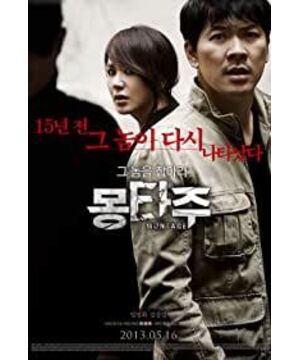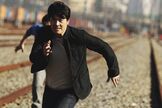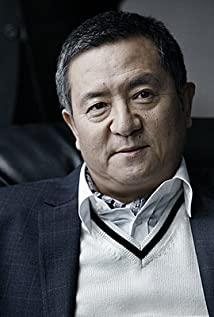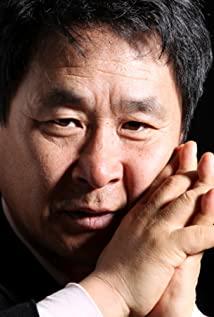It is a transliterated loanword, originally an architectural term, meaning composition and assembly. Often used in three art fields, it can be interpreted as a meaningful time-space artificial collage editing technique. It was first extended to film art, and later it was widely used in derivative fields such as visual art. Catalog Introduction Film Narrative Types Shrink and Expand Introduction Montage originally refers to the relationship between images and images. After the appearance of sound films and color films, image and sound (human voice, sound, music), sound and sound, color and color, Between light and shadow, the application of montage has a wider world. Montage has many names, so far there is no clear grammatical norm and classification, but the film industry generally tends to be divided into three categories: narrative, lyrical and rational (including symbolic, contrastive and metaphorical). After World War II, the French film theorist Andr Bazin (1918-1958) objected to the role of montage, believing that montage imposes the director's point of view on the audience, which limits the ambiguity of the film, and advocates the use of depth of field. Shots and mise-en-scène The long shot of the film, which is shot continuously, is believed to preserve the integrity of the plot space and the true flow of time. But the role of montage is undeniable, and film artists have always used both montage and long-lens methods to create films. Others believe that long takes actually use camera movement and actor scheduling to change the scope and content of the shot, and call it "inner montage". The major aspects of montage can be divided into performance montage and narrative montage, which can be subdivided into psychological montage, lyrical montage, parallel montage, cross montage, repetition montage and so on. The definition of montage is "splicing" in French but in Russia, it was developed into a theory of lens combination in movies, and montage is also a unique artistic technique and the meaning of free-style painting in the paint and coating industry. When different lenses are spliced together, there are often specific meanings that each lens does not have when it exists alone. Writing in this way is also called montage. In film literature, Liu Meng is the representative of the application of montage techniques to literature. Composition montage generally includes two aspects: picture editing and picture synthesis. Picture editing: a unified picture work composed of many pictures or patterns juxtaposed or superimposed, picture synthesis: the art or process of making this combination. The film combines a series of shots taken in different locations, from different distances and angles, and in different ways, to narrate the plot and portray the characters. Meaning When different lenses are grouped together, there is often a meaning that each lens does not have when it exists alone. For example, Chaplin's shot of driving the masses of workers into the factory gate is linked with the shot of the sheep being driven away; Pudovkin's shot of the melting glacier in spring is linked with the shot of workers' demonstrations, so that the original The footage takes on a new meaning. Eisenstein believed that when the parallel shots were joined together, the effect was "not the sum of the two numbers, but the product of the two numbers". With the role of montage, movies enjoy great freedom of time and space, and can even constitute movie time and movie space that are not consistent with the time and space in real life. Montage can create a third action beyond actor action and camera action, thereby affecting the rhythm of the film. Not long after the film came out, American directors, especially Griffith, noticed the role of film montage. Later Soviet directors Kurishov, Eisenstein and Pudovkin successively discussed and summarized the laws and theories of montage, forming a school of montage, and their relevant works had a profound impact on film creation. The main functions of montage are as follows: * Through the division and assembly of shots, scenes, and paragraphs, the material is selected and selected, so as to make the content of the performance clear and to achieve a high degree of generalization and concentration. * Guide the audience's attention and stimulate the audience's associations. Although each shot only expresses a certain content, a certain sequence of shots can regulate and guide the audience's emotions and psychology, and inspire the audience to think. * Create unique film and television time and space. Each shot is a record of real time and space. After editing, the reconstruction of time and space is realized, forming a unique film and television time and space. Through the means of montage, the narrative of the film obtains great freedom in the use of time and space. A single technique of turning in and out (or simply jumping in) can jump from Paris to New York in space, or across decades in time. Moreover, through the juxtaposition and intersection of the movements of two different spaces, tense suspense can be created, or the relationship between characters in two different places can be expressed, such as lovers' love between two places. A montage of different times can repeatedly depict the connection between a character's past psychological experiences and current inner activities. This freedom of time and space transformation enables the film to achieve to a large extent the freedom of the novelist's expression of life. The use of montage enables film artists to greatly compress or extend the actual time in life, resulting in the so-called "movie time", without giving people the feeling of violating the actual time in life. But it should be noted that the grasp of the montage can not be too long, otherwise it will be boring, nor too short, it will make people feel rushed. The ability of montage to manipulate time and space enables the film artist to extract, according to his analysis of life, what he thinks can best elucidate the essence of life, what can best illustrate the character and relationship of characters, and even the part that can best express the artist's own feelings , combined together, after decomposition and combination, retain the most important and inspiring parts, discard a lot of trivial trivialities, and refine life by removing the rubbish and saving the essence, and obtaining the most vivid narrative and richest appeal. . Griffith's "Partisan" shows the innocent husband watching the pain of his convicted wife in court, focusing only on her convulsing hands. In "The Red Detachment of Women", Qionghua saw the landlord Nan Batian and fired in violation of reconnaissance discipline. go through. The action is interrupted, but the plot is continuous and the character relationships are developed. The function of this decomposition and combination makes the film highly concentrated and generalized, so that a film of less than two hours can introduce a person's life and involve decades of social changes like "Citizen Kane". Montage also has two important functions that cannot be denied. One is to make the film alternately use narrative angles, such as from the author's objective narrative to the subjective expression of the character's heart, or to see a certain state of affairs through the character's eyes. Without this interchangeability, the film's narrative would be monotonous and awkward. The second is to affect the audience's psychology through the rhythm of the camera changing movement. The various functions of montage have convinced several generations of film artists and theorists that "montage is the foundation of film art", "without montage, there would be no film", and believed that film should adopt a special way of thinking - montage way of thinking. The ability of montage to manipulate time and space enables the film artist to extract, according to his analysis of life, what he thinks can best elucidate the essence of life, what can best illustrate the character and relationship of characters, and even the part that can best express the artist's own feelings , combined together, after decomposition and combination, retain the most important and inspiring parts, discard a lot of trivial trivialities, and refine life by removing the rubbish and saving the essence, and obtaining the most vivid narrative and richest appeal. . Griffith's "Partisan" shows the innocent husband watching the pain of his convicted wife in court, focusing only on her convulsing hands. In "The Red Detachment of Women", Qionghua saw the landlord Nan Batian and fired in violation of reconnaissance discipline. go through. The action is interrupted, but the plot is continuous and the character relationships are developed. The function of this decomposition and combination makes the film highly concentrated and generalized, so that a film of less than two hours can introduce a person's life and involve decades of social changes like "Citizen Kane". Montage also has two important functions that cannot be denied. One is to make the film alternately use narrative angles, such as from the author's objective narrative to the subjective expression of the character's heart, or to see a certain state of affairs through the character's eyes. Without this interchangeability, the film's narrative would be monotonous and awkward. The second is to affect the audience's psychology through the rhythm of the camera changing movement. The various functions of montage have convinced several generations of film artists and theorists that "montage is the foundation of film art", "without montage, there would be no film", and believed that film should adopt a special way of thinking - montage way of thinking. The ability of montage to manipulate time and space enables the film artist to extract, according to his analysis of life, what he thinks can best elucidate the essence of life, what can best illustrate the character and relationship of characters, and even the part that can best express the artist's own feelings , combined together, after decomposition and combination, retain the most important and inspiring parts, discard a lot of trivial trivialities, and refine life by removing the rubbish and saving the essence, and obtaining the most vivid narrative and richest appeal. . Griffith's "Partisan" shows the innocent husband watching the pain of his convicted wife in court, focusing only on her convulsing hands. In "The Red Detachment of Women", Qionghua saw the landlord Nan Batian and fired in violation of reconnaissance discipline. go through. The action is interrupted, but the plot is continuous and the character relationships are developed. The function of this decomposition and combination makes the film highly concentrated and generalized, so that a film of less than two hours can introduce a person's life and involve decades of social changes like "Citizen Kane". Montage also has two important functions that cannot be denied. One is to make the film alternately use narrative angles, such as from the author's objective narrative to the subjective expression of the character's heart, or to see a certain state of affairs through the character's eyes. Without this interchangeability, the film's narrative would be monotonous and awkward. The second is to affect the audience's psychology through the rhythm of the camera changing movement. The various functions of montage have convinced several generations of film artists and theorists that "montage is the foundation of film art" and that "without montage, there would be no film", and believed that film should adopt a special way of thinking - montage way of thinking. Montage also has two important functions that cannot be denied. One is to make the film alternately use narrative angles, such as from the author's objective narrative to the subjective expression of the character's heart, or to see a certain state of affairs through the character's eyes. Without this interchangeability, the film's narrative would be monotonous and awkward. The second is to affect the audience's psychology through the rhythm of the camera changing movement. The various functions of montage have convinced several generations of film artists and theorists that "montage is the foundation of film art", "without montage, there would be no film", and believed that film should adopt a special way of thinking - montage way of thinking. Montage also has two important functions that cannot be denied. One is to make the film alternately use narrative angles, such as from the author's objective narrative to the subjective expression of the character's heart, or to see a certain state of affairs through the character's eyes. Without this interchangeability, the film's narrative would be monotonous and awkward. The second is to affect the audience's psychology through the rhythm of the camera changing movement. The various functions of montage have convinced several generations of film artists and theorists that "montage is the foundation of film art", "without montage, there would be no film", and believed that film should adopt a special way of thinking - montage way of thinking.
View more about Montage reviews











